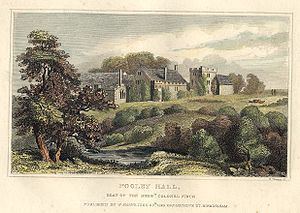 | ||
Similar Polesworth Abbey, Ashbourne Hall, Alvecote Priory, Fradley Junction, Daw Mill | ||
Hitler goes to pooley hall
Pooley Hall is a Manor house built in 1509 on the outskirts of Polesworth, Warwickshire, England. It is a Grade II* listed building and a private residence.
Contents
- Hitler goes to pooley hall
- Map of Pooley Hall Pooley Ln Polesworth Tamworth B78 1JA UK
- The Cockayne Family
- After The Cockaynes
- Today
- References
Map of Pooley Hall, Pooley Ln, Polesworth, Tamworth B78 1JA, UK
The Cockayne Family
The present Hall was built in 1509 by Sir Thomas Cockayne "The Magnificent", who was knighted at the Battle of Tournai by King Henry VII. It was built on the site of an earlier Hall and was one of the first examples in the country of a castellated brick-built manor house. The house was considerably larger than what it is today and has been repeatedly altered.
The Cockayne Family split their time between Pooley hall and their estate at Ashbourne Hall in Derbyshire.
Sir Aston Cockayne, 1st Baronet Cockayne, lived quietly at Pooley Hall for most of the English Interregnum. Sir Aston was a famous Cavalier and Catholic; during the English Civil War he took the Royalist side and in 1642 Charles I elevated him to Baronet. Sir Aston joined the future Charles II in exile for a time and chose to return to Pooley Hall to "lie low".
The family finances suffered heavily due to Sir Aston Cockayne. He was famous for his gambling and amassed large debts. Ashbourne Hall was sold within the first Baronet's lifetime, and after his death the family we're subsequently forced to sell Pooley Hall.
The family moved back to Derbyshire with several subsequent family-members famously becoming Mayors of Derby.
After The Cockaynes
Following the departure of the Cockayne Family, Pooley Hall fell into the hands of Charles Jennens of nearby Gopsall Hall and was subsequently inherited by Jennens' god-son The Hon. Charles Finch MP, son of the 3rd Earl of Aylesford.
In 1789 the Coventry Canal was opened. The canal runs through the Pooley Hall estate and passes within 20 meters of the Hall, which can be viewed from the tow-path on the opposite side of the canal.
In 1847 a coal mine was sunk on the Pooley Hall Estate, not far from the main House. It was completed in 1849 and coal began to be extracted in 1850.
In 1897 the Pooley Hall Colliery was formed. A wharf was constructed on the Canal for the Colliery and a branch line was built to connect it to the Trent Valley Line (Now part of the West Coast Main Line), that ran through nearby Polesworth.
In 1951 Pooley Hall Colliery joined with nearby Tamworth and Amington Collieries to form the North Warwick Colliery.
The Colliery eventually closed in 1965 and parts of the house, outbuildings and the colliery buildings had to be demolished due to mining subsidence.
Today
Today 62.5 hectares of the Pooley Hall Estate and Colliery site has been transformed into the "Pooley Country Park" operated by Warwickshire County Council. The Park has a visitors centre and is a popular site for dog walking.
Pooley Hall is once again a private residence and was, until recently, the home of the late Edwin Starr, an American Soul and Motown Singer.
